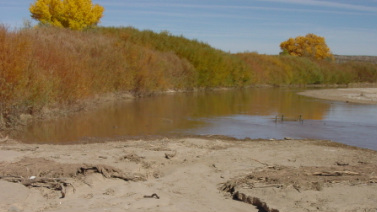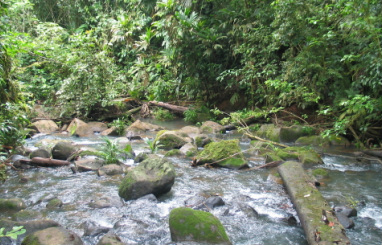Aridland river foodwebs, with a focus on light limitation effects on photosynthesizers

Middle Rio Grande in the fall, Sevilleta Wildlife Refuge
Aridland rivers face decreased flows and more pronounced effects of anthropogenic factors over time as water resources decline because of global warming. Many aridland rivers are naturally nutrient-limited in a landscape that is volcanic in origin. In the Middle Rio Grande in central New Mexico, nutrient sources, especially nitrogen, are related primarily to wastewater effluent and irrigation practices. Nutrient dynamics and other environmental parameters can affect algal biomass and species composition, influencing food resources for higher trophic levels. Seasonal surveys were conducted along a longitudinal gradient of the Middle Rio Grande (2007-2010, five sites). Physiochemical and algal parameters (chlorophyll a and species assemblages) were analyzed. Our results showed that naturally occurring higher turbidity levels versus elevated anthropogenic nitrate played both opposing and synchronized roles in shaping primary producer assemblages spatially and temporally
Biodiversity "hotspots" for diatom endemism

Hannaea arcus
The diatom genus Hannaea has been considered to be ecologically restricted to fast-moving, oligotrophic streams and rivers at higher elevations. Hannaea was thought to be not very speciose, with one species, H. arcus (Ehr.) Patrick in Patrick and Reimer, and several varieties commonly reported; however new data supports the description of several new taxa within the genus Hannaea from areas that appear to be locations of high diversity or ecological specialization. Hotspots of Hannaea speciation (noted by differences in morphology, ecology, and phylogeny) include the upper Great Lakes and Central Asia including Lake Baikal and Hovsgol and Mongolia streams.
Biodiversity and landscape patterns of diatoms in Neotropical streams

Sura-60, La Selva Biological Station, CostaRica
I study the biodiversity and landscape patterns of diatoms in lowland neotropical streams. These streams are located at La Selva Biological Station, located in lowlands of Costa Rica’s northern Caribbean slope. Estimates from these streams predict that nearly 30% of the species collected are new to science and that many more have been described only from the neotropics. Kayla Sayre and I are currently describing a new species of Amphipleura from the high solute streams at La Selva. A number of dominant taxa in high-solute streams are high conductivity tolerant taxa or freshwater members of a genus which formerly only contained marine and estuarine species.
In addition to illuminating the biodiversity of rainforest diatoms, these collections have been used to show relationships between species community changes and chemical/physical parameters. Distinct shifts in species composition in response to solute, light, and pH levels have been observed. This information can be used in environmental monitoring, giving a clear indication of ecosystem health.
In addition to illuminating the biodiversity of rainforest diatoms, these collections have been used to show relationships between species community changes and chemical/physical parameters. Distinct shifts in species composition in response to solute, light, and pH levels have been observed. This information can be used in environmental monitoring, giving a clear indication of ecosystem health.
